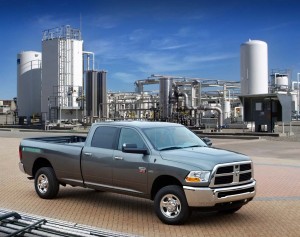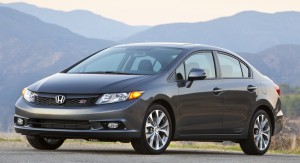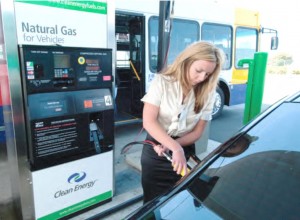Chrysler has landed orders from 19 states to supply Ram 2500 Heavy Duty pickup trucks running on compressed natural gas.
The move comes as 22 states form a coalition to promote the use of the cheap, plentiful and relatively clean fuel. The coalition has told U.S. automakers that if they build vehicles capable of running on CNG orders will run anywhere from 5,000 to 10,000 annually.
“That should be enough to get them to move,” said John Hickenlooper, the governor of Colorado which has been one of the states taking the lead in the effort to promote the use of CNG.
Compressed natural gas is gaining a lot of attention lately. Traditionally used for home heating as well as industrial applications, CNG is winning converts even in the environmental movement. While it is considered a fossil fuel its chemical structure contains less carbon than petroleum or coal and that means that in a motor vehicle it produces 60 to 90% fewer smog-causing pollutants and 30 to 40% less greenhouse gas emissions than gasoline, according to the U.S. Department of Energy.
Meanwhile, CNG supplies are growing rapidly through the use of technology commonly referred to as fracking which can access supplies of the gas that were inaccessible through traditional drilling methods. The U.S. now appears to have such a significant supply of the fuel that it may soon be able to stop importing CNG from Russia and other overseas sources.
So, where tightening supplies of petroleum have taken their toll at the pump – Californians now seeing record prices for gasoline – CNG is a relative bargain. Honda estimates that on a comparable basis, CNG costs the equivalent of $2.05 a gallon.
(Guest opinion: CNG is the “Buy American” alternative. Click Here.)
“Right now as a transition fuel, it’s way ahead of those other choices,” said Gov. Hickenlooper, referring to battery power and hydrogen fuel cells. “It’s less expensive, it’s cleaner.”
That last point might engender some debate but CNG proponents point out that a major share of the energy generated in the U.S. comes from coal which they contend means battery cars are not true zero-emission vehicles.
(New study casts doubt on environmental benefits of battery power. Click Here for more.)
Despite that, Honda is currently the only automaker offering a passenger car capable of running on the fuel in the U.S. market, a version of its compact Civic. There are only slightly more options in the truck market. For the moment, Chrysler is the only pickup truck maker with a factory CNG option, though Ford works with a number of aftermarket vendors who can convert its truck products to run on the fuel.
General Motors will soon add a bi-fuel option for its Chevrolet Silverado and GMC Sierra pickups, allowing a motorist to switch between gasoline or CNG.
(For more on the GM and Chrysler CNG trucks, Click Here.)
Meanwhile, the Vehicle Production Group offers a special wheelchair-accessible vehicle that can be ordered in either a gas-only or a bi-fuel package.
There are a number of vendors offering CNG conversion packages. They’ve become popular with taxi fleets in many cities as a way to curb runaway fuel costs. The lower price and reduced emissions has also added to CNG’s appeal for state and local government fleets.
“Customers want a choice when it comes to fuel because it helps them manage their business costs,” said Brian Small, general manager, GM Fleet and Commercial Operations. “We listened and we are going to move fast to bring a bi-fuel CNG product to market to meet our customer’s needs.”
But with CNG costing barely half as much as gasoline on a per-mile basis, why aren’t more consumers making the switch? There’s the up-front cost which can run to as much as $5,000 more than a comparable gasoline-powered vehicle – even more for some aftermarket conversions. And because CNG has to be stored at extremely high pressures it requires large and cumbersome fuel tanks that can gobble up passenger or cargo space.
But the biggest issue is the classic chicken-and-egg problem, limited availability – both of CNG vehicles and the necessary filling stations. For fleets, that may not be a problem. They generally know how many miles their vehicles will require and can provide the necessary private pump facilities.
For the public, however, it’s an entirely different matter. Oklahoma, which boasts having more public CNG filling stations than any other state nonetheless has a total of just 63, or slightly less than one for every 1,000 square miles.
Clean Energy Fuels, a company backed by CNG proponent T. Boone Pickens, has launched a cross-country expansion drive that will add liquefied natural gas pumps at 150 U.S. truck stops by 2014.
The goal is to “cover every major interstate” in the continental U.S., according to Chief Marketing Officer James Harger, who suggests, “This will help jump-start the industry.”
Perhaps, but automakers remain skeptical. Mercedes-Benz unveiled a CNG version of its new B-Class line at the recent Paris Motor Show. But while the German maker will run a small test fleet of battery-powered B-Class models in the U.S., a spokesman said there are no plans to bring over the CNG model.
Even Honda is struggling to make its egg hatch with a new offer of a free debit-card that will cover $3,000 in natural gas fuel charges for motorists who purchase the CNG Civic.
The White House last March proposed expanding the current incentives offered to battery-car buyers from the current $7,500 to $10,000. And it now wants CNG vehicles included in that tax rebate program. But little action is expected until after the election – and likely then only if Pres. Barack Obama is re-elected.
So, it’s anyone’s guess whether an abundant, clean and low-cost fuel that could readily offset a significant share of imported oil will ever gain momentum in the U.S. market.



